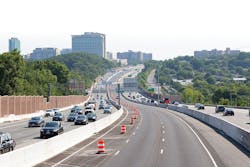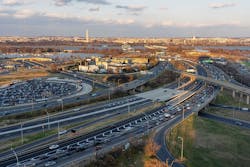Transurban’s latest project extends Northern Virginia express lanes to D.C.
In partnership with the Virginia DOT (VDOT), road system operator Transurban has undertaken the tremendous task of building an express lanes network in the Northern Virginia–Greater Washington area with several projects since the early half of the previous decade.
In 2012 and 2014, the express lanes operator delivered the 495 and 95 Express Lanes projects in Northern Virginia, which Transurban says have since helped save 17 million customers a cumulative 13 million hours on their travel. The initial segment of the 95 Express Lanes is a 31-mile segment between Springfield and Garrisonville, Virginia. Despite the network’s success, it failed to connect into Washington, D.C. to the north or to Stafford County, Virginia to the south, which is considered the fastest growing suburban area to the nation’s capital.
The solution to connect to the metro D.C. area would become what is now known as the 395 Express Lanes. This $475 million project, which began in August 2017 and opened to traffic in November 2019, is an 8-mile extension of the 95 Express Lanes north from Springfield, Virginia into D.C. The project expanded and converted the existing I-395 high-occupancy vehicle (HOV) system from two HOV lanes to three high-occupancy toll (HOT) lanes, merging seamlessly with the existing 95 Express Lanes.
“So the southern limit of the 395 Express Lanes picks up from the northern limits of the 95 Express Lanes, and it extends all the way up north to the 14th Street Bridge,” Kevin Ginnerty, Project Delivery Director for Transurban, told Roads & Bridges. “It makes a final seamless connection from the southern terminus of the 95 Express Lanes just south of Garrisonville Road all the way up to the Washington, D.C. line.”
This work also gave way to the future extension to Fredericksburg, Virginia, an endeavor that would add another 10 miles of express lanes to what is already the longest reversible facility in the country by 2022.
NOTABLE MILESTONES
The 395 Express Lanes are tolled, reversible lanes operating alongside free lanes on I-395 in Northern Virginia.
The first of the major milestones to be completed on the 395 Express Lanes project was completing all the work on the Pentagon Reservation by the spring of 2019 in order to expedite that work and make sure it was done prior to the opening of the express lanes, as well as to meet the needs of the Pentagon, which was doing a significant follow-along project at the Eads Street ramps that come off 395 to move the traffic more efficiently in and around the Pentagon.
Once the team achieved the second major milestone of opening the 395 Express Lanes in November 2019, the final significant piece was to finish all other work—including the VDOT-related portions of the project, which included the fourth lane widening of the general purpose lanes on the 395 southbound side between Duke Street and Edsall Road. “It gave the VDOT general purpose lane users much more capacity and addressed the significant need along the general purpose lanes, as well as finishing up five bridge rehabilitations that were on the general purpose lanes and all the sound walls that were built as part of the project,” Ginnerty said. “All that significant work was completed in summer and fall of 2020.”
The project also included the rehabilitation of 14 aging bridges. The existing infrastructure along this corridor was approximately 50 years old, so when project developments were done, the team took a look at the existing condition of the pavement, the bridge structures, and other critical elements—including roadway safety features. Transurban looked at what they could do to get the biggest benefit for seamless and safe travel and still keep the project schedule going. “The work on a lot of the bridges involved a hydrodemolition of the top 1.5 in. to 3 in. of the concrete deck,” Ginnerty explained. “And then we put a latex-modified concrete back over the top of it and reconstructed all the joints and most of the bridge barriers to upgrade it from both a safety perspective as well as a life-cycle perspective to try to get us a good 20+ years out for not having to do anything on the bridges again—that would open up the roadway quicker, more efficiently, and safer for the general public.”
In addition to the bridge rehabilitation work, the project also included new or modified sound walls and drainage improvements along the corridor, as well as a package of additional infrastructure improvements for the Commonwealth, including a fourth general purpose lane on part of I-395, new bus and carpool pick-up lanes (or slug-lanes) in the Pentagon South Parking Lot, and an improved Eads Street interchange that enables easier access to the Pentagon and growing Crystal City neighborhood of Arlington, Virginia.
OVERCOMING OBSTACLES
When work on the project began in August 2017, one of the most significant challenges was finding ways to minimize impacts to commuters. One of the ways this was achieved was through active engagement with neighborhoods and communities around the corridor. Transurban engaged community partners regularly through more than 250 community and stakeholder meetings, weekly coordination with local governments and the Pentagon, on-the-ground engagement at local events, and weekly multimedia communications on project impacts.
Another major challenge for Transurban was managing the safety of contractors during construction, which took place in a confined space between barriers with active traffic on either side in one of the busiest travel corridors in the region. In addition to that, the 395 HOV lanes needed to remain open during the day, which meant most of the construction took place at night. The contractor had to hit certain milestones each night with the knowledge that no matter what, the road would need to open again in the morning to allow commuters to get where they needed to go.
“It really challenged the group to work in traditionally off hours,” Ginnerty said. “We did a lot of work at night, did a lot of work on the weekends, and then tried to schedule and phase the work that could be done efficiently during the day without any of the traffic lane shutdowns. This also presented a very tight corridor to try to work in, which presented its own set of safety concerns and challenges.”
Ginnerty said another significant challenge in the design process was at the Eads Street interchange, where the team significantly changed the entirety of traffic operations in the area and turned the ramps into reversible ramps. Prior to Transurban coming onto the project, there were dedicated ramps that would only be used in one direction. However, there were significant traffic constraints with taking people off of the 395 roadways down to Eads Street, and then splitting the traffic to go left into the Pentagon or right into Crystal City. Since the roadway underneath was challenged to handle that volume of traffic, one of Transurban’s engineers came up with the idea to split the traffic. “So if you were going to the Pentagon, you would exit off the left in the morning, and if you were going to Crystal City, you would retain the exit to the right, and then reverse-flow in the afternoon,” Ginnerty explained. “We fully changed the whole configuration in that area, enabled the split of the traffic, and made traffic flow considerably better.”
WHAT’S NEXT?
The next major express lanes endeavor for Transurban in Northern Virginia is the Fredericksburg Extension (FredEx) project, which will extend the existing reversible 95 Express Lanes south by 10 miles along the I-95 median. The project includes new access points to the existing I-95 Express Lanes, new ramps, and seven new bridges.
Ground was broken on this project in June 2019, representing another major milestone in Transurban and VDOT’s vision for reduced congestion along I-95. The project will transform travel along the I-95 corridor between Fairfax and Stafford Counties in Virginia by unlocking the nation’s number one traffic hot-spot as ranked by INRIX in 2017. By extending the existing 95 Express Lanes south by 10 miles, the project will deliver 66% more capacity during peak periods and will move 30% more people through the corridor. Once completed, the $565 million project will be a key linkage in the 49-mile network of the longest reversible, dynamic tolled facility in the nation along I-95.
As for the 395 Express Lanes, Transurban says there are a few minor checklist items remaining, with an official completion date, as of this writing, of Dec. 7, 2020.
The 395 project is considered to be a success in economic impact metrics, as the new express lanes are projected to generate more than 8,700 jobs, $1 billion in economic impact, and exceed DBE/SWaM contracting goals with more than $100 million in contracts awarded.
On top of that, Transurban has committed to more work in the region, including an annual $15 million payment towards I-95/395 corridor transit improvements, widening of portions of the regular I-395 travel lanes, and support of over 70 community organizations with $280,000 in grant funding. Transurban’s annual $15 million transit payment is expected to generate billions of dollars in public transportation investment over the course of the decades-long concession, with many funded projects already realized.


